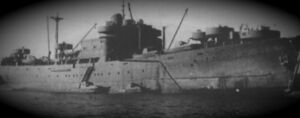Minenraumschiff 25
| Minenraumschiff 25 | |||
|---|---|---|---|
 Bildet viser søsterskipet MRS26 | |||
| Tekniske data | |||
| Type | Minerydder | ||
| Lengde (m) | 106,9 | ||
| Bredde (m) | 14,9 | ||
| Dypgående (m) | 6,3 | ||
| Tonnasje | 3500 brt | ||
| Karriere | |||
| Rederi | Deutche Kriegsmarine | ||
| Bygget | Moss ( N ) 1944 | ||
| Andre navn | MRS 25 | ||
| Skjebne | senket av magnetisk mine | ||
| Dykket | |||
| Tilgjengelighet | båt | ||
| Dykkedybde | 35-45m | ||
|
Karthjelpen:
| |||
Historie [1]
Deutche Kriegsmarines Minenraumschiff 25 var et identisk søsterskip til MRS 26 som begge ble bygget ved Moss verft for eieren Lorentzen i Oslo, i de første årene av den andre verdenskrig. Underveis til ferdigstillelse ble byggingen av MRS 25 overtatt av det tyske Kriegsmarine, som bestemte at skipet skulle ferdigstilles som et Minenraumschiffe. I 1944 ble MRS 25 sjøsatt ved Moss, og deretter sendt nordover for å gjøre tjeneste som Minenraumschiffe. I motsetning til MRS 26 overlevde skipet den andre verdenskrig, og ble sammen med mange andre skip satt til å rense opp den Norske kysten for miner. Den 18 juli 1945 ryddet MRS 25 miner i området ved Ballangen fyr for GM/SA, da hun plutselig seiler rett på en magnetisk mine og synker. Idag hviler vraket av MRS 25 i relativt god stand rett utenfor Mortsund på en dybde av trettifem til førtifem meter. En båt er nødvendig for å komme ut til vrakstedet...
Historie [2]
After World War I, the German Navy was allowed ot keep 34 of the 130 Minesweepers build during the war. Most of 450 ships of the 1916 type were used for mine hunting, but some of them did perform as submarine tenders, training ships or escorts. Well known with their black color and coal fired steam engines, those vessels were replaced by modern ships in the mid 1930s. In the mid 1930s, the minesweeping flotillas of the Kriegsmarine consisted of old ships build in World War I. To replace this old ships, a class of modern minesweepers, the "Mboot35" was designed. The result was a very maneuverable and seaworthy ship exceeding the expectations. Heavily armed those ships were often called "Channel Destroyers" by the British during World War II. Despite the successful design, several factors prevented that a large number of ships were build during the war. The boats were very expensive and complicated to build, therefore a more simple design had to be developed (which later got the Minensuchboot 1940). The engines were difficult to maintain and needed specially skilled personal which was not available in the required numbers. Since the Mboot35 had oil fired boilers, they also suffered from the oil shortage in the later years of the war. A total of 69 ships were build in eight different shipyards, 34 were lost during the war. After the war, 17 were taken over by the US Navy, 5 by the Royal Navy and 13 by the Soviet Navy which all were used in the Black Sea until the 1960s. Five of the ships taken over by the USA were returned to Germany in 1956/57 and were used by the Bundesmarine. As a successor of the Minensuchboot 1935 the MBoot 40 showed some design similarities, but was of a different origin. Since the Minensuchboot 1935 was quite complicated and expensive to build a, the new class of ships was based on the last mine hunter design of World War I, the "MBoot 16". The result was a ship that was about 10% less capable than the Minensuchboot 1935, but only took half effort to build. Like its predecessors ,those boats were not used for mine hunting alone, but were also used for escort duties and other types of operations. With its coal fired boiler this ships could even be operated then the fuel supplies of the Kriegsmarine had reached a critical level. Of the 131 boats build - most of them in Dutch shipyards - 63 were lost during the war. 30 were taken over by the Soviets, 25 by the USA and 13 by the British. The ships used by the Soviet navy were used until the 1960, most of them in the Baltic Sea, five of the ships formerly took over by the USA were given to the new formed Bundesmarine in 1957. The last active ships in this class are four vessels of the Romanian navy that were still in service as corvettes in 1994 (Demokratia, Descatusaria, Desrobrea and Dreptatea). The MBoot 43 was the enlarged successor of the mine hunter type MBoot 40. To speed up the construction, those mine hunter were not build in the conventional way anymore, but by separate pre-fabricated sections which were only put together in the shipyard (like the Type XXI submarine). Although the primary objective for these vessels was mine hunting, they could also be equipped with depth charges and used as submarine hunters, some were also used as torpedo training ships and had two torpedo tubes installed. Like their predecessors, the MBoot 43 had coal fired steam engines, which made those vessels easier operational in the last years of the war. Over 160 ships of the MBoot 43 class were ordered from 1942 on, but only 17 were completed until the end of the war. All but one survived the war and were taken over by the allies, some of them serving until the late 1960s...
Været
<yr>Norge/Nordland/Vestvågøy/Mortsund/</yr>
[1]==Referanser==
- ↑ Orginalt fra skovheim.org
- ↑ Orginalt fra "German Kriegsmarine Encyclopedia"